A Nature-Based Approach Using Felled Burnt Logs to Enhance Forest Recovery Post-Fire and Reduce Erosion Phenomena in the Mediterranean Area
Abstract
1. Introduction
- -
- to confirm the effectiveness of the in situ use of collapsed burnt logs manually redirected to reduce the slope and the hydrological response, in order to quickly counteract the triggering of erosion phenomena (short-term effect);
- -
- to assess, more than 2 years after its implementation, the effects of the naturalistic measure on the self-regenerative dynamics of the forest ecosystem, in order to restore the maximum ecological and protective functionality of the woodland over time (long-term effect);
- -
- to evaluate the durability of the wood barriers also for their implementation in the bioengineering field, in order to test how long the structural function of the measure can be prolonged before the forest becomes established;
- -
- to deepen the regulatory aspects concerning the practicability of the remediation measure.
2. Materials and Methods
- -
- description of the study area and characterisation of the extreme wildfire event that occurred in 2021 in the Aspromonte Massif;
- -
- description and characterisation of the experimental site;
- -
- collection and elaboration of data concerning (i) forest regeneration, (ii) hydrological response (runoff and sediment yields) and (iii) biotechnical and worksite aspects.
2.1. Characterisation of Extreme Wildfire Event That Occurred in 2021 in the Aspromonte Massif
2.2. Description and Characterisation of the Experimental Site
2.3. Data Collection and Elaboration
2.3.1. Forest Regeneration Aspects
2.3.2. Hydrological Aspects
2.3.3. Biotechnical and Worksite Aspects
2.3.4. Statistical Analysis
3. Results and Discussion
3.1. Assessment of Forest Ecosystem Changes and Dynamics Post-Fire
3.1.1. Pioneer Vegetation
3.1.2. Auto-Regeneration of Pinus Radiata
3.2. Effects on Runoff and Sediment Yield
3.3. Durability and Mechanical Properties of In Situ Logs
4. The Legal Regulatory Framework on Wildfires
5. Final Remarks and Research Perspectives
Author Contributions
Funding
Data Availability Statement
Acknowledgments
Conflicts of Interest
Appendix A
| F | df1 | df2 | p | |
|---|---|---|---|---|
| Sediment F | 60.016 | 1 | 17.2 | 0.025 |
| Sediment B | 218.024 | 1 | 27.3 | <0.001 |
| Sediment BR | 208.164 | 1 | 23.3 | <0.001 |
| Runoff C | 0.4086 | 1 | 17.6 | 0.531 |
| Runoff B | 0.0283 | 1 | 15.2 | 0.869 |
| Runoff BR | 0.0259 | 1 | 15.0 | 0.874 |
| Sum of Squares | df | Mean Square | F | p | |
|---|---|---|---|---|---|
| Plot | 2.93 × 106 | 2 | 1.47 × 106 | 6.11 | 0.003 |
| VegCover | 9.27 × 106 | 1 | 9.27 × 106 | 38.62 | <0.001 |
| Intensity | 3.32 × 106 | 1 | 3.32 × 106 | 13.85 | <0.001 |
| Rain | 630,274 | 1 | 630,274 | 2.63 | 0.109 |
| Plot ∗ VegCover | 2.13 × 106 | 2 | 1.07 × 106 | 4.45 | 0.015 |
| Residuals | 1.97 × 107 | 82 | 240,038 |
| Comparison | |||||||||
|---|---|---|---|---|---|---|---|---|---|
| Plot | Cover Veg. | Plot | Cover Veg. | Mean Difference | SE | df | t | ptukey | |
| F | 1 | - | F | 2 | 258.02 | 204 | 82.0 | 12.668 | 0.802 |
| B | 1 | - | B | 2 | 1067.12 | 204 | 82.0 | 52.394 | <0.001 |
| BR | 1 | - | BR | 2 | 896.82 | 204 | 82.0 | 44.032 | <0.001 |
| F | 1 | - | B | 1 | −895.83 | 148 | 82.0 | −60.643 | <0.001 |
| F | 2 | - | B | 2 | −86.73 | 245 | 82.0 | −0.3541 | 0.999 |
| F | 1 | - | BR | 1 | −645.80 | 148 | 82.0 | −43.717 | <0.001 |
| F | 2 | - | BR | 2 | −7.00 | 245 | 82.0 | −0.0286 | 1.000 |
| B | 1 | - | BR | 1 | 250.03 | 148 | 82.0 | 16.926 | 0.541 |
| B | 2 | - | BR | 2 | 79.73 | 245 | 82.0 | 0.3255 | 0.999 |
| Sum of Squares | df | Mean Square | F | p | |
|---|---|---|---|---|---|
| Plot | 106.129 | 2 | 53.065 | 27.541 | <0.001 |
| VegCover | 7.030 | 1 | 7.030 | 3.649 | 0.060 |
| Rain | 180.865 | 1 | 180.865 | 93.872 | <0.001 |
| Intensity | 30.536 | 1 | 30.536 | 15.849 | <0.001 |
| Plot ∗ VegCover | 0.015 | 2 | 0.007 | 0.004 | 0.996 |
| Residuals | 157.991 | 82 | 1.927 |
| Comparison | |||||||||
|---|---|---|---|---|---|---|---|---|---|
| Plot | Cover Veg. | Plot | Cover Veg. | Mean Difference | SE | df | t | ptukey | |
| F | 1 | - | F | 2 | 0.643 | 0.577 | 82.0 | 1.114 | 0.874 |
| B | 1 | - | B | 2 | 0.610 | 0.577 | 82.0 | 1.058 | 0.896 |
| BR | 1 | - | BR | 2 | 0.682 | 0.577 | 82.0 | 1.181 | 0.845 |
| F | 1 | - | B | 1 | −2.925 | 0.419 | 82.0 | −6.989 | <0.001 |
| F | 2 | - | B | 2 | −2.957 | 0.694 | 82.0 | −4.261 | <0.001 |
| F | 1 | - | BR | 1 | −2.034 | 0.419 | 82.0 | −4.859 | <0.001 |
| F | 2 | - | BR | 2 | −1.995 | 0.694 | 82.0 | −2.875 | 0.056 |
| B | 1 | - | BR | 1 | 0.891 | 0.419 | 82.0 | 2.130 | 0.283 |
| B | 2 | - | BR | 2 | 0.963 | 0.694 | 82.0 | 1.387 | 0.735 |
| ID Log | Survey | Distance between Sensors (cm) | Stress Wave Velocity (m/s) (Standard Deviation) |
|---|---|---|---|
| L1 | 1 December 2021 | 29 | 1014 (1.23) |
| L2 | 22 | 1692 (1.25) | |
| L3 | 25 | 1851 (0.96) | |
| L4 | 22 | 824 (2.36) | |
| L5 | 35 | 1891 (2.89) | |
| L6 | 49 | 1884 (0.98) | |
| L1 | 22 April 2022 | 29 | 933 (1.56) |
| L2 | 22 | 1651 (2.66) | |
| L3 | 25 | 1677 (1.33) | |
| L4 | 22 | 785 (1.98) | |
| L5 | 35 | 1794 (1.11) | |
| L6 | 49 | 1678 (2.93) | |
| L1 | 15 November 2022 | 29 | 890 (2.14) |
| L2 | 22 | 1509 (1.47) | |
| L3 | 25 | 1552 (1.18) | |
| L4 | 22 | 748 (1.61) | |
| L5 | 35 | 1602 (2.16) | |
| L6 | 49 | 1459 (2.92) | |
| L1 | 10 April 2023 | 29 | 861 (1.58) |
| L2 | 22 | 1324 (1.62) | |
| L3 | 25 | 1403 (1.39) | |
| L4 | 22 | 719 (1.16) | |
| L5 | 35 | 1513 (2.54) | |
| L6 | 49 | 1308 (1.63) |
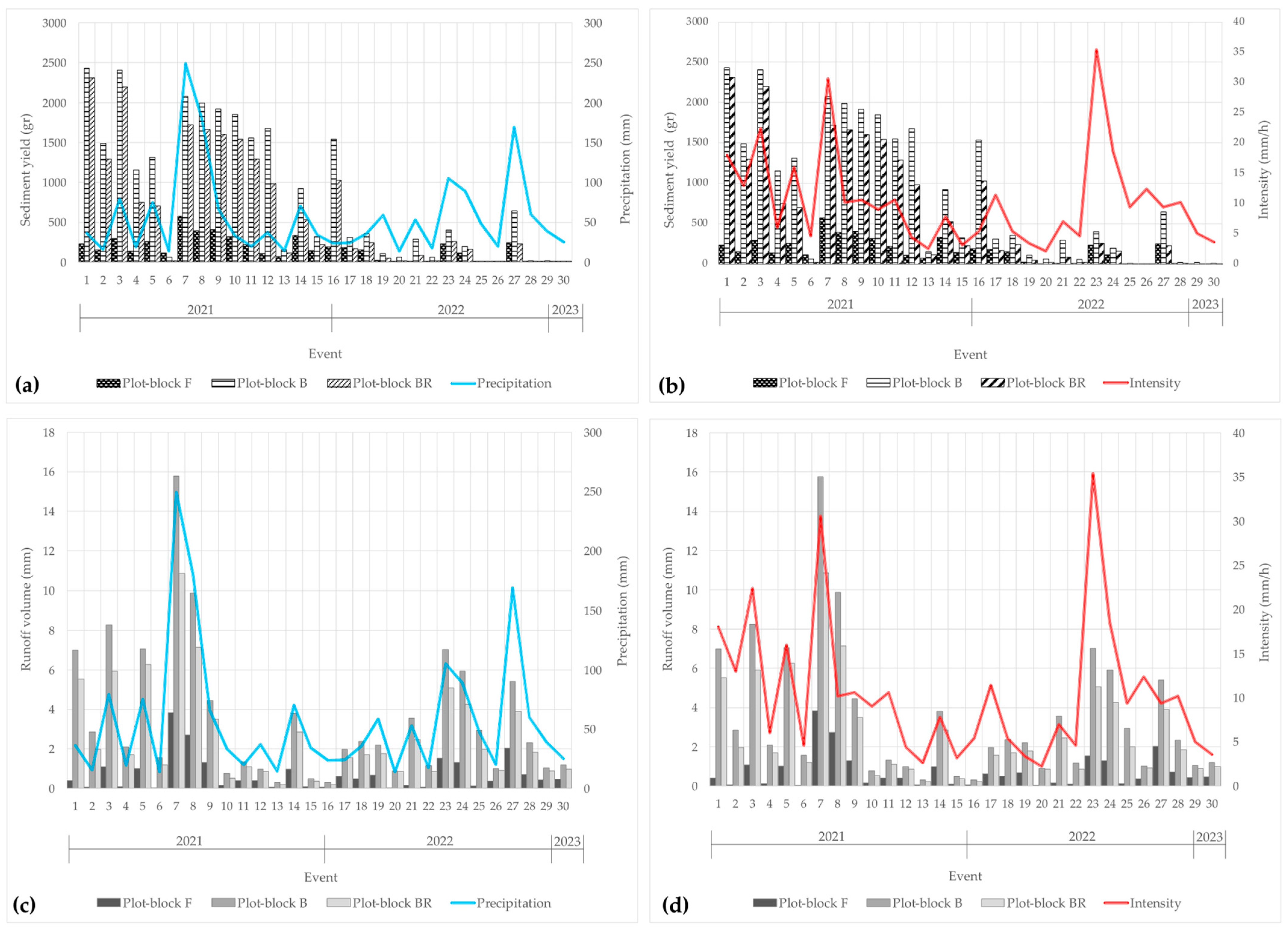
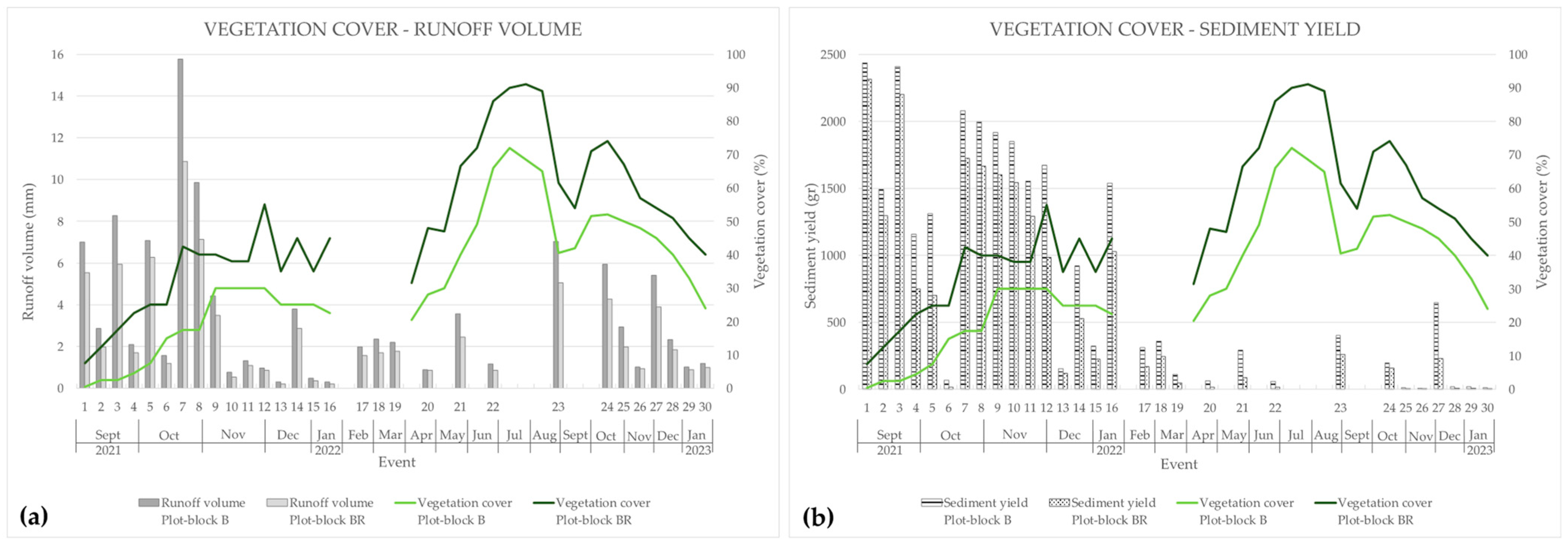

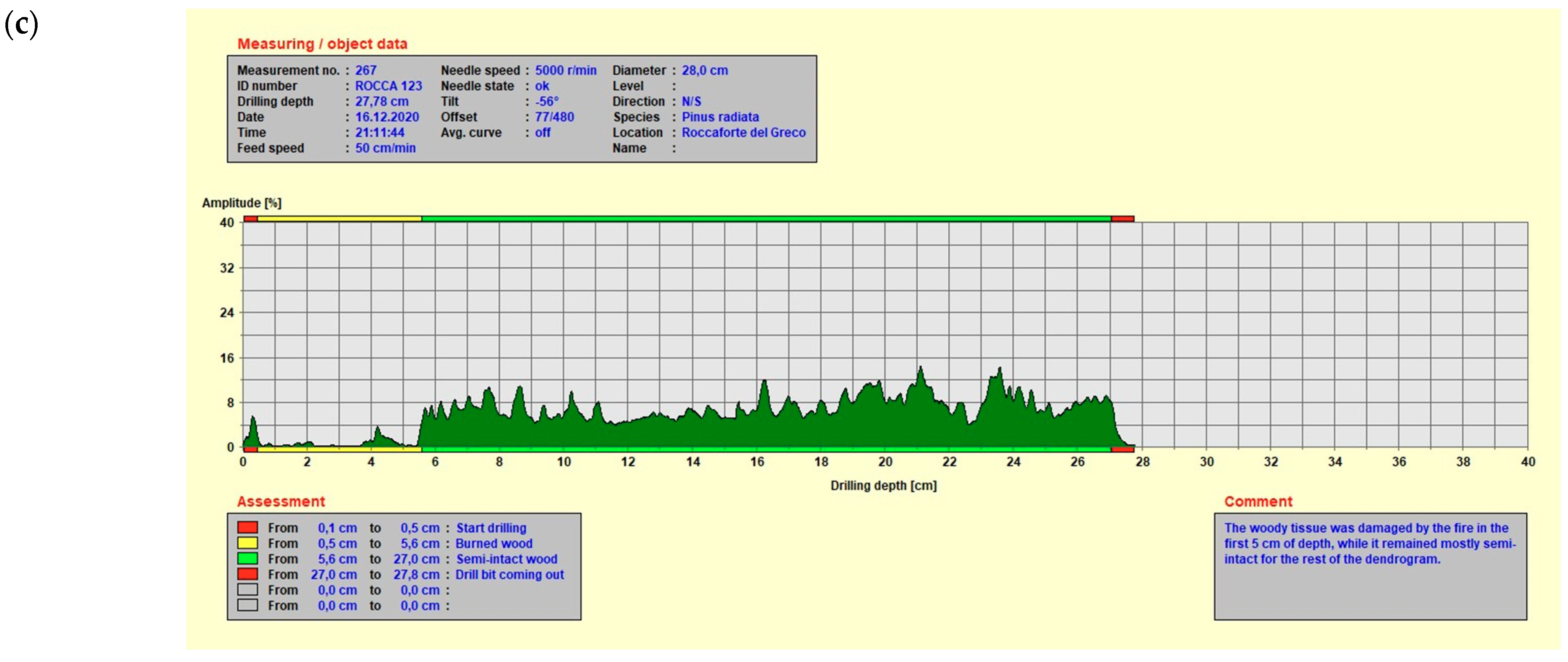
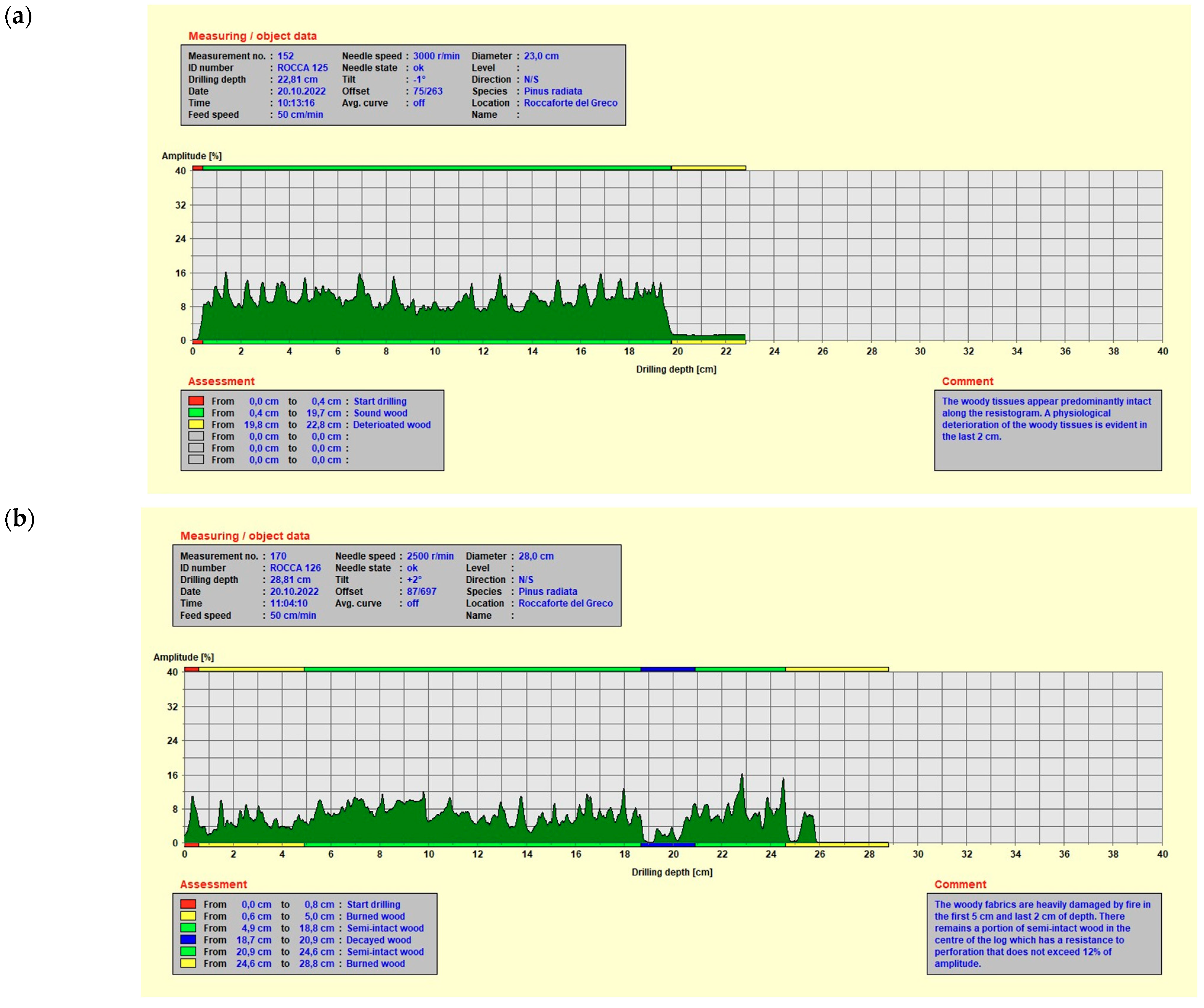
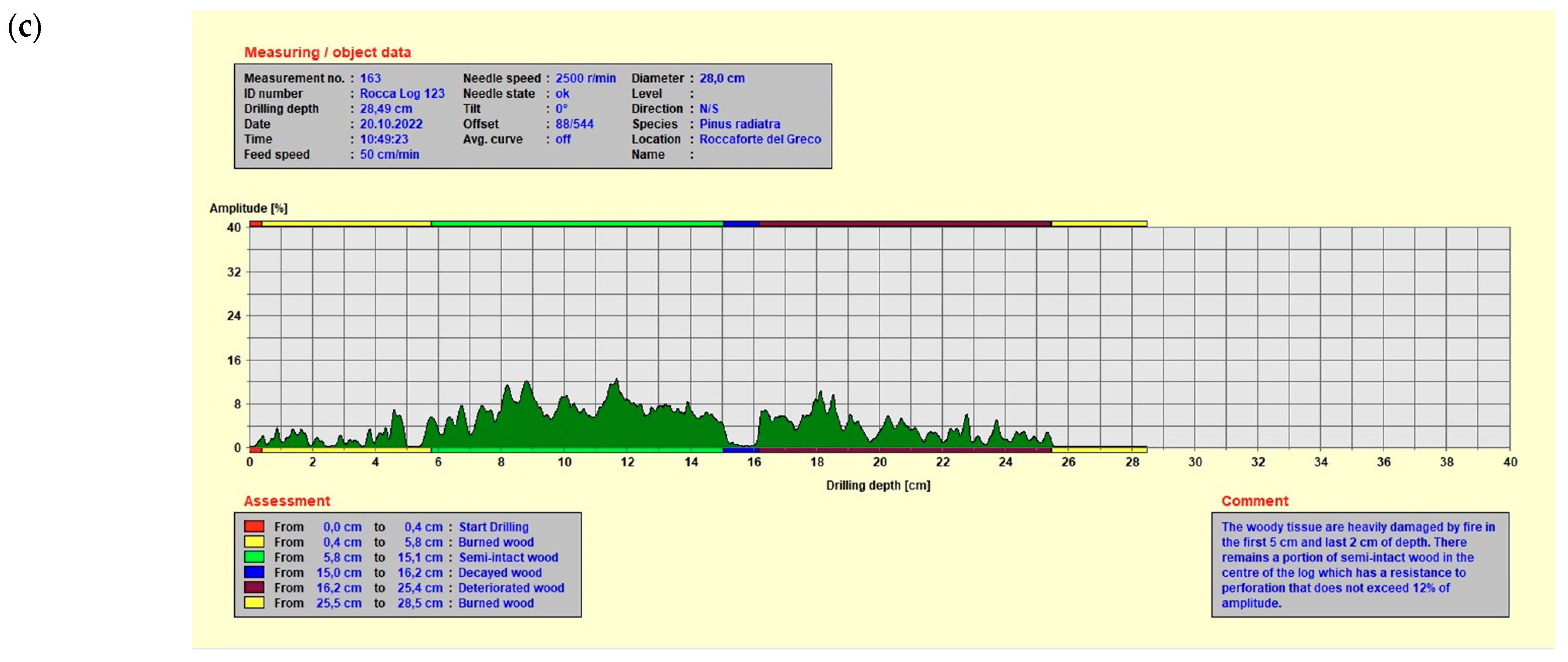
References
- Carrión, J.S.; Sánchez-Gómez, P.; Mota, J.F.; Yll, R.; Chaín, C. Holocene Vegetation Dynamics, Fire and Grazing in the Sierra de Gádor, Southern Spain. Holocene 2003, 13, 839–849. [Google Scholar] [CrossRef]
- Fernandes, P.M.; Monteiro-Henriques, T.; Guiomar, N.; Loureiro, C.; Barros, A.M.G. Bottom-Up Variables Govern Large-Fire Size in Portugal. Ecosystems 2016, 19, 1362–1375. [Google Scholar] [CrossRef]
- Rodrigues, M.; Cunill Camprubí, À.; Balaguer-Romano, R.; Coco Megía, C.J.; Castañares, F.; Ruffault, J.; Fernandes, P.M.; Resco de Dios, V. Drivers and Implications of the Extreme 2022 Wildfire Season in Southwest Europe. Sci. Total Environ. 2023, 859, 160320. [Google Scholar] [CrossRef] [PubMed]
- dos Santos, S.M.B.; Bento-Gonçalves, A.; Franca-Rocha, W.; Baptista, G. Assessment of Burned Forest Area Severity and Postfire Regrowth in Chapada Diamantina National Park (Bahia, Brazil) Using dNBR and RdNBR Spectral Indices. Geosciences 2020, 10, 106. [Google Scholar] [CrossRef]
- Hosseini, M.; Keizer, J.J.; Pelayo, O.G.; Prats, S.A.; Ritsema, C.; Geissen, V. Effect of Fire Frequency on Runoff, Soil Erosion, and Loss of Organic Matter at the Micro-Plot Scale in North-Central Portugal. Geoderma 2016, 269, 126–137. [Google Scholar] [CrossRef]
- Fernandez-Anez, N.; Krasovskiy, A.; Müller, M.; Vacik, H.; Baetens, J.; Hukić, E.; Kapovic Solomun, M.; Atanassova, I.; Glushkova, M.; Bogunović, I.; et al. Current Wildland Fire Patterns and Challenges in Europe: A Synthesis of National Perspectives. Air Soil Water Res. 2021, 14, e117862212110281. [Google Scholar] [CrossRef]
- Ascoli, D.; Marchetti, M. Territorio, bioeconomia e gestione degli incendi: Una sfida da raccogliere al più presto|SISEF.ORG. For. J. Silvic. For. Ecol. 2018, 15, 71. [Google Scholar]
- San-Miguel-Ayanz, J.; Durrant, T.; Boca, R.; Maianti, P.; Libertá, G.; Artés-Vivancos, T.; Oom, D.; Branco, A.; de Rigo, D.; Ferrari, D.; et al. Forest Fires in Europe, Middle East and North Africa 2021; Publications Office of the European Union: Luxembourg, 2022. [Google Scholar]
- Shakesby, R. Post-Wildfire Soil Erosion in the Mediterranean: Review and Future Research Directions. Earth-Sci. Rev. 2011, 105, 71–100. [Google Scholar] [CrossRef]
- Whelan, R.J. The Ecology of Fire; Cambridge University Press: Cambridge, UK, 1995. [Google Scholar]
- Morgan, P.; Hardy, C.C.; Swetnam, T.W.; Rollins, M.G.; Long, D.G. Mapping Fire Regimes across Time and Space: Understanding Coarse and Fine-Scale Fire Patterns. Int. J. Wildland Fire 2001, 10, 329–342. [Google Scholar] [CrossRef]
- DeBano, L.F.; Neary, D.G.; Ffolliott, P.F. Fire Effects on Ecosystems; John Wiley & Sons: Hoboken, NJ, USA, 1998. [Google Scholar]
- Neary, D.G.; Klopatek, C.C.; DeBano, L.F.; Ffolliott, P.F. Fire Effects on Belowground Sustainability: A Review and Synthesis. For. Ecol. Manag. 1999, 122, 51–71. [Google Scholar] [CrossRef]
- Key, C.H.; Benson, N.C. Post-Fire Burn Assessment by Remote Sensing on National Park Service Lands, and Measuring and Remote Sensing of Burn Severity; US Geological Survey Wildland Fire Workshop: Los Alamos, NM, USA, 2002; pp. 2–11. [Google Scholar]
- Smith, A.M.S.; Hudak, A.T.; Smith, A.M.S.; Hudak, A.T. Estimating Combustion of Large Downed Woody Debris from Residual White Ash. Int. J. Wildland Fire 2005, 14, 245–248. [Google Scholar] [CrossRef]
- Montenegro, G.; Ginocchio, R.; Segura, A.; Keely, J.E.; Gomez, M. Fire Regimes and Vegetation Responses in Two Mediterranean-Climate Regions. Rev. Chil. Hist. Nat. 2004, 77, 455–464. [Google Scholar] [CrossRef]
- Pérez-Cabello, F.; Echeverría, M.T.; Ibarra, P.; De La Riva, J. Effects of Fire on Vegetation, Soil and Hydrogeomorphological Behavior in Mediterranean Ecosystems. In Earth Observation of Wildland Fires in Mediterranean Ecosystems; Chuvieco, E., Ed.; Springer: Berlin/Heidelberg, Germany, 2009; pp. 111–128. ISBN 978-3-642-01753-7. [Google Scholar]
- Santana, V.M.; Alday, J.G.; Baeza, M.J. Effects of Fire Regime Shift in Mediterranean Basin Ecosystems: Changes in Soil Seed Bank Composition among Functional Types. Plant Ecol. 2014, 215, 555–566. [Google Scholar] [CrossRef]
- Barbati, A.; Arianoutsou, M.; Corona, P.; De Las Heras, J.; Fernandes, P.; Moreira, F.; Papageorgiou, K.; Vallejo, R.; Xanthopoulos, G. Post-Fire Forest Management in Southern Europe: A COST Action for Gathering and Disseminating Scientific Knowledge. IForest-Biogeosciences For. 2010, 3, 5. [Google Scholar] [CrossRef]
- Francos, M.; Úbeda, X.; Tort, J.; Panareda, J.M.; Cerdà, A. The Role of Forest Fire Severity on Vegetation Recovery after 18 Years. Implications for Forest Management of Quercus suber L. in Iberian Peninsula. Glob. Planet. Chang. 2016, 145, 11–16. [Google Scholar] [CrossRef]
- Gómez-Sánchez, E.; Lucas-Borja, M.E.; Plaza-Álvarez, P.A.; González-Romero, J.; Sagra, J.; Moya, D.; De Las Heras, J. Effects of Post-Fire Hillslope Stabilisation Techniques on Chemical, Physico-Chemical and Microbiological Soil Properties in Mediterranean Forest Ecosystems. J. Environ. Manag. 2019, 246, 229–238. [Google Scholar] [CrossRef] [PubMed]
- Robinne, F.-N.; Hallema, D.W.; Bladon, K.D.; Buttle, J.M. Wildfire Impacts on Hydrologic Ecosystem Services in North American High-Latitude Forests: A Scoping Review. J. Hydrol. 2020, 581, 124360. [Google Scholar] [CrossRef]
- Cerdà, A.; Borja, M.E.L.; Úbeda, X.; Martínez-Murillo, J.F.; Keesstra, S. Pinus halepensis M. versus Quercus ilex Subsp. Rotundifolia L. Runoff and Soil Erosion at Pedon Scale under Natural Rainfall in Eastern Spain Three Decades after a Forest Fire. For. Ecol. Manag. 2017, 400, 447–456. [Google Scholar] [CrossRef]
- Ebel, B.A.; Moody, J.A. Synthesis of Soil-Hydraulic Properties and Infiltration Timescales in Wildfire-Affected Soils. Hydrol. Process. 2017, 31, 324–340. [Google Scholar] [CrossRef]
- García-Comendador, J.; Fortesa, J.; Calsamiglia, A.; Calvo-Cases, A.; Estrany, J. Post-Fire Hydrological Response and Suspended Sediment Transport of a Terraced Mediterranean Catchment. Earth Surf. Process. Landf. 2017, 42, 2254–2265. [Google Scholar] [CrossRef]
- Cavalli, M.; Vericat, D.; Pereira, P. Mapping Water and Sediment Connectivity. Sci. Total Environ. 2019, 673, 763–767. [Google Scholar] [CrossRef] [PubMed]
- Shakesby, R.A.; Doerr, S.H. Wildfire as a Hydrological and Geomorphological Agent. Earth-Sci. Rev. 2006, 74, 269–307. [Google Scholar] [CrossRef]
- Shakesby, R.A.; Bento, C.P.M.; Ferreira, C.S.S.; Ferreira, A.J.D.; Stoof, C.R.; Urbanek, E.; Walsh, R.P.D. Impacts of Prescribed Fire on Soil Loss and Soil Quality: An Assessment Based on an Experimentally-Burned Catchment in Central Portugal. CATENA 2015, 128, 278–293. [Google Scholar] [CrossRef]
- Nunes, J.P.; Bernard-Jannin, L.; Rodríguez-Blanco, M.L.; Boulet, A.-K.; Santos, J.M.; Keizer, J.J. Impacts of Wildfire and Post-Fire Land Management on Hydrological and Sediment Processes in a Humid Mediterranean Headwater Catchment. Hydrol. Process. 2020, 34, 5210–5228. [Google Scholar] [CrossRef]
- Sanesi, G.; Lafortezza, R.; Colangelo, G.; Marziliano, P.A.; Davies, C. Root System Investigation in Sclerophyllous Vegetation: An Overview. Ital. J. Agron. 2013, 8, e17. [Google Scholar] [CrossRef]
- Cos, J.; Doblas-Reyes, F.; Jury, M.; Marcos, R.; Bretonnière, P.-A.; Samsó, M. The Mediterranean Climate Change Hotspot in the CMIP5 and CMIP6 Projections. Earth Syst. Dyn. 2022, 13, 321–340. [Google Scholar] [CrossRef]
- Coello, J.; Cortina, J.; Valdecantos, A.; Varela, E. Forest Landscape Restoration Experiences in Southern Europe: Sustainable Techniques for Enhancing Early Tree Performance; FAO: Rome, Italy, 2015; Volume 66. [Google Scholar]
- Romeo, F.; Marziliano, P.A.; Turrión, M.B.; Muscolo, A. Short-Term Effects of Different Fire Severities on Soil Properties and Pinus Halepensis Regeneration. J. For. Res. 2020, 31, 1271–1282. [Google Scholar] [CrossRef]
- de Pagter, T.; Lucas-Borja, M.E.; Navidi, M.; Carra, B.G.; Baartman, J.; Zema, D.A. Effects of Wildfire and Post-Fire Salvage Logging on Rainsplash Erosion in a Semi-Arid Pine Forest of Central Eastern Spain. J. Environ. Manag. 2023, 329, 117059. [Google Scholar] [CrossRef]
- Proto, A.R.; Bernardini, V.; Cataldo, M.F.; Zimbalatti, G. Whole Tree System Evaluation of Thinning a Pine Plantation in Southern Italy. Ann. Silvic. Res. 2020, 45, 44–52. [Google Scholar]
- Bedia, J.; Herrera, S.; Camia, A.; Moreno, J.M.; Gutiérrez, J.M. Forest Fire Danger Projections in the Mediterranean Using ENSEMBLES Regional Climate Change Scenarios. Clim. Chang. 2014, 122, 185–199. [Google Scholar] [CrossRef]
- Dimitrakopoulos, A.; Gogi, C.; Stamatelos, G.; Mitsopoulos, I. Statistical Analysis of the Fire Environment of Large Forest Fires (>1000 Ha) in Greece. Pol. J. Environ. Stud. 2011, 20, 327–332. [Google Scholar]
- Robichaud, P.R.; Ashmun, L.E.; Sims, B.D. Post-Fire Treatment Effectiveness for Hillslope Stabilization; Gen. Tech. Rep. RMRS-GTR-240. Fort Collins, CO: U.S. Department of Agriculture, Forest Service, Rocky Mountain Research Station; DIANE Publishing: Darby, PA, USA, 2010; Volume 240. [Google Scholar] [CrossRef]
- de Figueiredo, T.; Fonseca, F.; Lima, E.; Fleischfresser, L.; Hernandez Hernandez, Z. Assessing Performance of Post-Fire Hillslope Erosion Control Measures Designed for Different Implementation Scenarios in NE Portugal: Simulations Applying USLE. In Wildfires: Perspectives, Issues and Challenges of the 21st Century; Nova Science Publisher: New York, NY, USA, 2017; pp. 201–227. [Google Scholar]
- Fernández-García, V.; Fulé, P.Z.; Marcos, E.; Calvo, L. The Role of Fire Frequency and Severity on the Regeneration of Mediterranean Serotinous Pines under Different Environmental Conditions. For. Ecol. Manag. 2019, 444, 59–68. [Google Scholar] [CrossRef]
- Robichaud, P.R.; Lewis, S.A.; Wagenbrenner, J.W.; Brown, R.E.; Pierson, F.B. Quantifying Long-Term Post-Fire Sediment Delivery and Erosion Mitigation Effectiveness. Earth Surf. Process. Landf. 2020, 45, 771–782. [Google Scholar] [CrossRef]
- Robichaud, P.R.; Wagenbrenner, J.W.; Lewis, S.A.; Ashmun, L.E.; Brown, R.E.; Wohlgemuth, P.M. Post-Fire Mulching for Runoff and Erosion Mitigation Part II: Effectiveness in Reducing Runoff and Sediment Yields from Small Catchments. CATENA 2013, 105, 93–111. [Google Scholar] [CrossRef]
- Robichaud, P.R.; Wagenbrenner, J.W.; Brown, R.E.; Wohlgemuth, P.M.; Beyers, J.L. Evaluating the Effectiveness of Contour-Felled Log Erosion Barriers as a Post-Fire Runoff and Erosion Mitigation Treatment in the Western United States. Int. J. Wildland Fire 2008, 17, 255–273. [Google Scholar] [CrossRef]
- Rey, F.; Bifulco, C.; Bischetti, G.B.; Bourrier, F.; De Cesare, G.; Florineth, F.; Graf, F.; Marden, M.; Mickovski, S.B.; Phillips, C. Soil and Water Bioengineering: Practice and Research Needs for Reconciling Natural Hazard Control and Ecological Restoration. Sci. Total Environ. 2019, 648, 1210–1218. [Google Scholar] [CrossRef]
- Béguin, P.; Millet, J.; Aubert, J.-P. Cellulose Degradation by Clostridium Thermocellum: From Manure to Molecular Biology. FEMS Microbiol. Lett. 1992, 100, 523–528. [Google Scholar] [CrossRef]
- Lasanta, T.; Cerdà, A. Long-Term Erosional Responses after Fire in the Central Spanish Pyrenees: 2. Solute Release. CATENA 2005, 60, 81–100. [Google Scholar] [CrossRef]
- Inbar, M.; Wittenberg, L.; Tamir, M. Soil Erosion and Forestry Management after Wildfire in a Mediterranean Woodland, Mt. Carmel, Israel. Int. J. Wildland Fire 1997, 7, 285–294. [Google Scholar] [CrossRef]
- Inbar, M.; Tamir, M.I.; Wittenberg, L. Runoff and Erosion Processes after a Forest Fire in Mount Carmel, a Mediterranean Area. Geomorphology 1998, 24, 17–33. [Google Scholar] [CrossRef]
- Badía, D.; Martí, C. Plant Ash and Heat Intensity Effects on Chemicaland Physical Properties of Two Contrasting Soils. Arid Land Res. Manag. 2003, 17, 23–41. [Google Scholar] [CrossRef]
- Gimeno-García, E.; Andreu, V.; Rubio, J.L. Influence of Vegetation Recovery on Water Erosion at Short and Medium-Term after Experimental Fires in a Mediterranean Shrubland. CATENA 2007, 69, 150–160. [Google Scholar] [CrossRef]
- Mayor, A.G.; Bautista, S.; Llovet, J.; Bellot, J. Post-Fire Hydrological and Erosional Responses of a Mediterranean Landscpe: Seven Years of Catchment-Scale Dynamics. CATENA 2007, 71, 68–75. [Google Scholar] [CrossRef]
- Faivre, N.; Fritz, M.; Freitas, T.; de Boissezon, B.; Vandewoestijne, S. Nature-Based Solutions in the EU: Innovating with Nature to Address Social, Economic and Environmental Challenges. Environ. Res. 2017, 159, 509–518. [Google Scholar] [CrossRef] [PubMed]
- O’Hogain, S.; McCarton, L. A Technology Portfolio of Nature Based Solutions: Innovations in Water Management; Springer: Cham, Switzerland, 2018. [Google Scholar] [CrossRef]
- Grant, G. Ecosystem Services Come To Town: Greening Cities by Working with Nature; John Wiley & Sons: Hoboken, NJ, USA, 2012; ISBN 978-1-118-38788-7. [Google Scholar]
- López-Vicente, M.; Kramer, H.; Keesstra, S. Effectiveness of Soil Erosion Barriers to Reduce Sediment Connectivity at Small Basin Scale in a Fire-Affected Forest. J. Environ. Manag. 2021, 278, 111510. [Google Scholar] [CrossRef]
- Raftoyannis, Y.; Spanos, I.; Raftoyannis, Y.; Spanos, I. Evaluation of Log and Branch Barriers as Post-Fire Rehabilitation Treatments in a Mediterranean Pine Forest in Greece. Int. J. Wildland Fire 2005, 14, 183–188. [Google Scholar] [CrossRef]
- USDA Forest Service. Emergency Stabilization—Burned-Area Emergency Response (BAER). In Forest Service Manual FSM 2500, Watershed and Air Management; USDA Forest Service: Washington, DC, USA, 2004. [Google Scholar]
- Bombino, G.; Barbaro, G.; Pérez-Cutillas, P.; D’Agostino, D.; Denisi, P.; Foti, G.; Zimbone, S.M. Use of Logs Downed by Wildfires as Erosion Barriers to Encourage Forest Auto-Regeneration: A Case Study in Calabria, Italy. Water 2023, 15, 2378. [Google Scholar] [CrossRef]
- Alexander, M.E.; Cruz, M.G.; Taylor, S.W. Crown Scorch Height. In Encyclopedia of Wildfires and Wildland-Urban Interface (WUI) Fires; Manzello, S.L., Ed.; Springer International Publishing: Cham, Switzerland, 2018; pp. 1–7. ISBN 978-3-319-51727-8. [Google Scholar]
- Arkin, J.; Coops, N.C.; Daniels, L.D.; Plowright, A. A Novel Post-Fire Method to Estimate Individual Tree Crown Scorch Height and Volume Using Simple RPAS-Derived Data. Fire Ecol. 2023, 19, 17. [Google Scholar] [CrossRef] [PubMed]
- Sorriso-Valvo, M.; Terranova, O. The Calabrian Fiumara Streams. Z. Für Geomorphol. Land Degrad. Suppl. 2006, 143, 109–125. [Google Scholar]
- Sabato, L.; Tropeano, M. Fiumara: A Kind of High Hazard River. Phys. Che. Earth 2004, 29, 707–715. [Google Scholar] [CrossRef]
- Bombino, G. A (New) Suggestive Hypothesis about the Origin of the Term Fiumara (Seasonally-Flowing and High Hazard Streams of Southern Italy). Mediterr. Chron. 2020, 10, 163–173. [Google Scholar]
- Key, C.H.; Benson, N.C. Landscape assessment (LA). FIREMON Fire Eff. Monit. Inventory Syst. 2006, 164, LA-1-55. [Google Scholar]
- De Luca, G.; Modica, G.; Silva, J.M.N.; Praticò, S.; Pereira, J.M.C. Assessing Tree Crown Fire Damage Integrating Linear Spectral Mixture Analysis and Supervised Machine Learning on Sentinel-2 Imagery. Int. J. Digit. Earth 2023, 16, 3162–3198. [Google Scholar] [CrossRef]
- García, M.J.L.; Caselles, V. Mapping Burns and Natural Reforestation Using Thematic Mapper Data. Geocarto Int. 1991, 6, 31–37. [Google Scholar] [CrossRef]
- Escuin, S.; Navarro, R.; Fernández, P. Fire Severity Assessment by Using NBR (Normalized Burn Ratio) and NDVI (Normalized Difference Vegetation Index) Derived from LANDSAT TM/ETM Images. Int. J. Remote Sens. 2008, 29, 1053–1073. [Google Scholar] [CrossRef]
- De Luca, G.; Silva, J.M.N.; Modica, G. Short-Term Temporal and Spatial Analysis for Post-Fire Vegetation Regrowth Characterization and Mapping in a Mediterranean Ecosystem Using Optical and SAR Image Time-Series. Geocarto Int. 2022, 37, 15428–15462. [Google Scholar] [CrossRef]
- De Luca, G.; Silva, J.M.N.; Modica, G. A Workflow Based on Sentinel-1 SAR Data and Open-Source Algorithms for Unsupervised Burned Area Detection in Mediterranean Ecosystems. GIScience Remote Sens. 2021, 58, 516–541. [Google Scholar] [CrossRef]
- De Luca, G.; Silva, J.M.N.; Modica, G. Regional-Scale Burned Area Mapping in Mediterranean Regions Based on the Multitemporal Composite Integration of Sentinel-1 and Sentinel-2 Data. GIScience Remote Sens. 2022, 59, 1678–1705. [Google Scholar] [CrossRef]
- Gorelick, N.; Hancher, M.; Dixon, M.; Ilyushchenko, S.; Thau, D.; Moore, R. Google Earth Engine: Planetary-Scale Geospatial Analysis for Everyone. Remote Sens. Environ. 2017, 202, 18–27. [Google Scholar] [CrossRef]
- Lutes, D.C.; Keane, R.E.; Caratti, J.F.; Key, C.H.; Benson, N.C.; Sutherland, S.; Gangi, L.J. FIREMON: Fire Effects Monitoring and Inventory System; U.S. Department of Agriculture, Forest Service, Rocky Mountain Research Station: Fort Collins, CO, USA, 2006; p. RMRS-GTR-164. [Google Scholar]
- Kottek, M.; Grieser, J.; Beck, C.; Rudolf, B.; Rubel, F. World Map of the Köppen-Geiger Climate Classification Updated. Meteorol. Z. 2006, 15, 259–263. [Google Scholar] [CrossRef]
- Braun-Blanquet, J. Zur Kenntnis Der Vegetationsverhältnisse Des Grossen Atlas; Buchdruckerei Gebr. Fretz AG: Zürich, Switzerland, 1928. [Google Scholar]
- Vogel, K.P.; Masters, R.A. Frequency Grid—A Simple Tool for Measuring Grassland Establishment. J. RANGE Manag. 2001, 54, 653–655. [Google Scholar] [CrossRef]
- Keesstra, S.D.; Maroulis, J.; Argaman, E.; Voogt, A.; Wittenberg, L. Effects of Controlled Fire on Hydrology and Erosion under Simulated Rainfall. Cuad. Investig. Geográfica 2014, 40, 269–294. [Google Scholar] [CrossRef]
- Szewczyk, G.; Wąsik, R.; Leszczyński, K.; Podlaski, R. Age Estimation of Different Tree Species Using a Special Kind of an Electrically Recording Resistance Drill. Urban For. Urban Green. 2018, 34, 249–253. [Google Scholar] [CrossRef]
- Rinn, F.; Schweingruber, F.-H.; Schär, E. RESISTOGRAPH and X-Ray Density Charts of Wood. Comparative Evaluation of Drill Resistance Profiles and X-Ray Density Charts of Different Wood Species. Holzforschung 1996, 50, 303–311. [Google Scholar] [CrossRef]
- Tannert, T.; Anthony, R.W.; Kasal, B.; Kloiber, M.; Piazza, M.; Riggio, M.; Rinn, F.; Widmann, R.; Yamaguchi, N. In Situ Assessment of Structural Timber Using Semi-Destructive Techniques. Mater. Struct. 2014, 47, 767–785. [Google Scholar] [CrossRef]
- Schimleck, L.; Dahlen, J.; Apiolaza, L.A.; Downes, G.; Emms, G.; Evans, R.; Moore, J.; Pâques, L.; Van den Bulcke, J.; Wang, X. Non-Destructive Evaluation Techniques and What They Tell Us about Wood Property Variation. Forests 2019, 10, 728. [Google Scholar] [CrossRef]
- Sharapov, E.; Brischke, C.; Militz, H. Assessment of Preservative-Treated Wooden Poles Using Drilling-Resistance Measurements. Forests 2020, 11, 20. [Google Scholar] [CrossRef]
- Papandrea, S.F.; Cataldo, M.F.; Zimbalatti, G.; Proto, A.R. Comparative Evaluation of Inspection Techniques for Decay Detection in Urban Trees. Sens. Actuators Phys. 2022, 340, 113544. [Google Scholar] [CrossRef]
- Sharapov, E.; Brischke, C.; Militz, H.; Smirnova, E. Effects of White Rot and Brown Rot Decay on the Drilling Resistance Measurements in Wood. Holzforschung 2018, 72, 905–913. [Google Scholar] [CrossRef]
- Ceraldi, C.; Mormone, V.; Russo Ermolli, E. Resistographic Inspection of Ancient Timber Structures for the Evaluation of Mechanical Characteristics. Mater. Struct. 2001, 34, 59–64. [Google Scholar] [CrossRef]
- Park, C.-Y.; Kim, S.-J.; Lee, J.-J. Evalulation of Specific Gravity in Post Member by Drilling Resistance Test. J. Korean Wood Sci. Technol. 2006, 34, 1–9. [Google Scholar]
- Acuña, L.; Basterra, L.A.; Casado, M.M.; López, G.; Ramón-Cueto, G.; Relea, E.; Martínez, C.; González, A. Application of Resistograph to Obtain the Density and to Differentiate Wood Species. Mater. Constr. 2011, 61, 451–464. [Google Scholar] [CrossRef]
- Karlinasari, L.; Danu, M.I.; Nandika, D.; Tujaman, M. Drilling Resistance Method to Evaluate Density and Hardness Properties of Resinous Wood of Agarwood (Aquilaria Malaccensis). WOOD Res. 2017, 6, 683–690. [Google Scholar]
- Wyjadłowski, M.; Nowak, T.; Karolak, A. Investigation of Wooden Sheet Pile Wall in an Aggressive Environment Using Non-Destructive Methods. MATEC Web Conf. 2018, 251, 02038. [Google Scholar] [CrossRef]
- Dafis, S.A. Silvicultural Measures for Forest Fire Prevention and Rehabilitation after Fires; Joint Committee on Forest Technology, Management, and Training: Geneva, Switzerland, 1991. [Google Scholar]
- Daskalakou, E.; Thanos, C. Aleppo Pine (Pinus Halepensis) Postfire Regeneration: The Role of Canopy and Soil Seed Banks. Int. J. Wildland Fire 1996, 6, 59. [Google Scholar] [CrossRef]
- Marziliano, P.A.; Menguzzato, G.; Barreca, L.; Scuderi, A. Post-fire regeneration of a Pinus halepensis forest in Mediterranean environment. In Proceedings of the Atti del Secondo Congresso Internazionale di Selvicoltura. In Proceedings of the Second International Congress of Silviculture, Florence, Italy, 26–29 November 2014; Accademia Italiana di Scienze Forestali: Firenze, Italy, 2015; pp. 432–437. [Google Scholar]
- Wilson, J.B.; Gitay, H.; Roxburgh, S.H.; King, W.M.; Tangney, R.S. Egler’s Concept of “Initial Floristic Composition” in Succession: Ecologists Citing It Don’t Agree What It Means. Oikos 1992, 64, 591–593. [Google Scholar] [CrossRef]
- Wilson, J.B. Does the Initial Floristic Composition Model of Succession Really Work? J. Veg. Sci. 2014, 25, 4–5. [Google Scholar] [CrossRef]
- Egler, F.E. Vegetation Science Concepts I. Initial Floristic Composition, a Factor in Old-Field Vegetation Development. Vegetatio 1954, 4, 412–417. [Google Scholar] [CrossRef]
- Harvey, B.J.; Holzman, B.A. Divergent Successional Pathways of Stand Development Following Fire in a California Closed-Cone Pine Forest. J. Veg. Sci. 2014, 25, 88–99. [Google Scholar] [CrossRef]
- Gall, C.; Nebel, M.; Quandt, D.; Scholten, T.; Seitz, S. Pioneer Biocrust Communities Prevent Soil Erosion in Temperate Forests after Disturbances. Biogeosciences 2022, 19, 3225–3245. [Google Scholar] [CrossRef]
- García-Carmona, M.; Lepinay, C.; Mataix-Solera, J.; Baldrian, P.; Arcenegui, V.; Cajthaml, T.; García-Orenes, F. Post-Fire Wood Mulch Negatively Affects the Moss Biocrust Cover and Its Positive Effects on Microbial Diversity in a Semi-Arid Mediterranean Forest. Appl. Soil Ecol. 2023, 191, 105026. [Google Scholar] [CrossRef]
- Ebel, B.A. Temporal Evolution of Measured and Simulated Infiltration Following Wildfire in the Colorado Front Range, USA: Shifting Thresholds of Runoff Generation and Hydrologic Hazards. J. Hydrol. 2020, 585, 124765. [Google Scholar] [CrossRef]
- Partington, D.; Thyer, M.; Shanafield, M.; McInerney, D.; Westra, S.; Maier, H.; Simmons, C.; Croke, B.; Jakeman, A.J.; Gupta, H.; et al. Predicting Wildfire Induced Changes to Runoff: A Review and Synthesis of Modeling Approaches. WIREs Water 2022, 9, e1599. [Google Scholar] [CrossRef]
- Graber, A.P.; Thomas, M.A.; Kean, J.W. How Long Do Runoff-Generated Debris-Flow Hazards Persist After Wildfire? Geophys. Res. Lett. 2023, 50, e2023GL105101. [Google Scholar] [CrossRef]
- Gomez Isaza, D.F.; Cramp, R.L.; Franklin, C.E. Fire and Rain: A Systematic Review of the Impacts of Wildfire and Associated Runoff on Aquatic Fauna. Glob. Chang. Biol. 2022, 28, 2578–2595. [Google Scholar] [CrossRef]
- Lucas-Borja, M.E.; Van Stan, J.T., II; Heydari, M.; Omidipour, R.; Rocha, F.; Plaza-Alvarez, P.A.; Zema, D.A.; Muñoz-Rojas, M. Post-Fire Restoration with Contour-Felled Log Debris Increases Early Recruitment of Spanish Black Pine (Pinus nigra arn. Ssp. Salzmannii) in Mediterranean Forests. Restor. Ecol. 2021, 29, e13338. [Google Scholar] [CrossRef]
- Stupazzini, R. Il Governo Degli Incendi Boschivi Alla Luce Dei Più Recenti Interventi Normativi. Profili Organizzativi e Attività Amministrative Nelle Diverse Fasi Di Gestione Dell’evento. Riv. Quadrimestrale Dirit. Dell’ambiente 2022, 1/2022, 285–340. [Google Scholar]
- Lucas-Borja, M.E.; Delgado-Baquerizo, M.; Muñoz-Rojas, M.; Plaza-Álvarez, P.A.; Gómez-Sanchez, M.E.; González-Romero, J.; Peña-Molina, E.; Moya, D.; de las Heras, J. Changes in Ecosystem Properties after Post-Fire Management Strategies in Wildfire-Affected Mediterranean Forests. J. Appl. Ecol. 2021, 58, 836–846. [Google Scholar] [CrossRef]
- Balestra, M. I Boschi Urbani e la Tutela Paesaggistica e Forestale—Riv. Giur. Dir. Quotid. Leg. 2023, 1/2023, 5–11. [Google Scholar]
- Mattarella, B.G. La Semplificazione Amministrativa Come Strumento Di Sviluppo Economico. Astrid Rass. 2019, 1–10. [Google Scholar]
- Elvan, O.D.; Birben, Ü.; Özkan, U.Y.; Yıldırım, H.T.; Türker, Y.Ö. Forest Fire and Law: An Analysis of Turkish Forest Fire Legislation Based on Food and Agriculture Organization Criteria. Fire Ecol. 2021, 17, 12. [Google Scholar] [CrossRef]


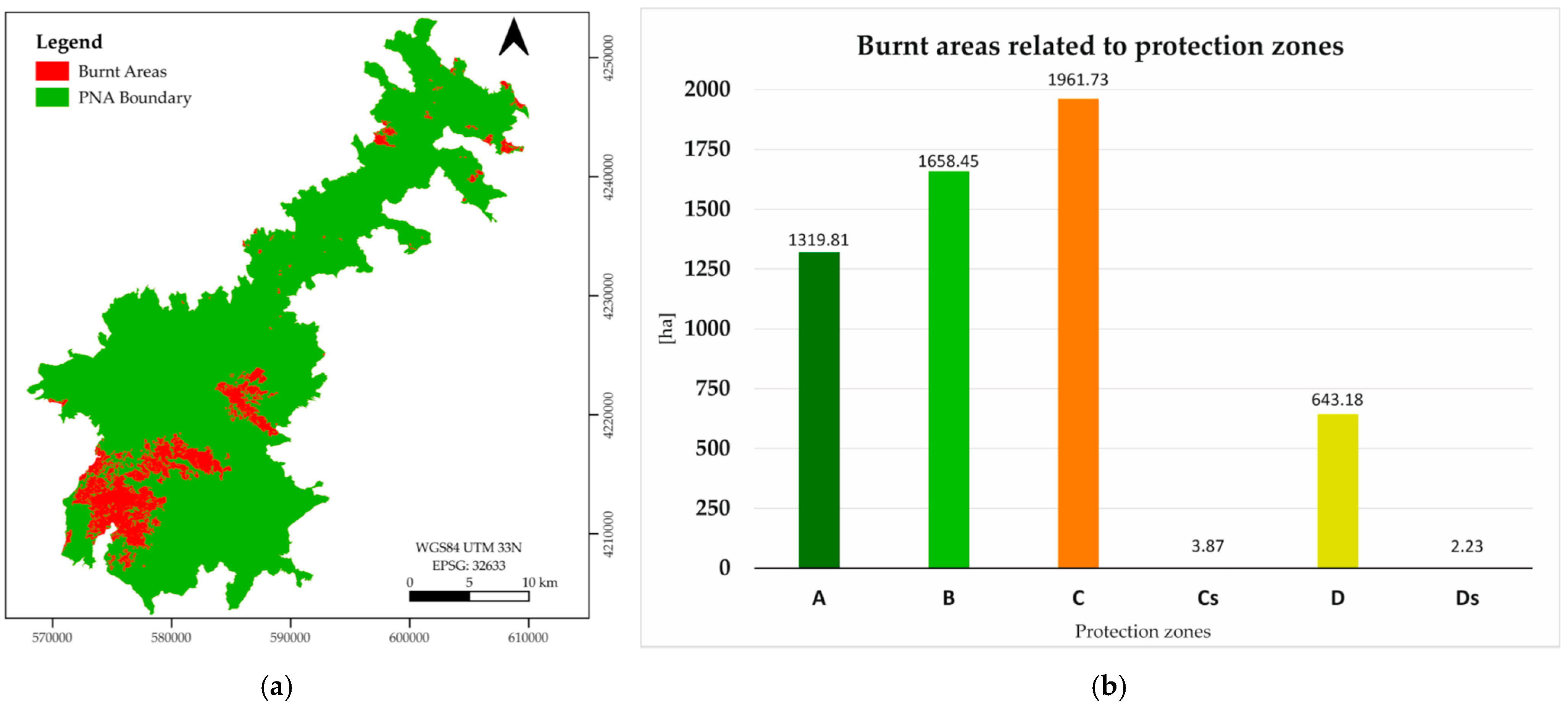

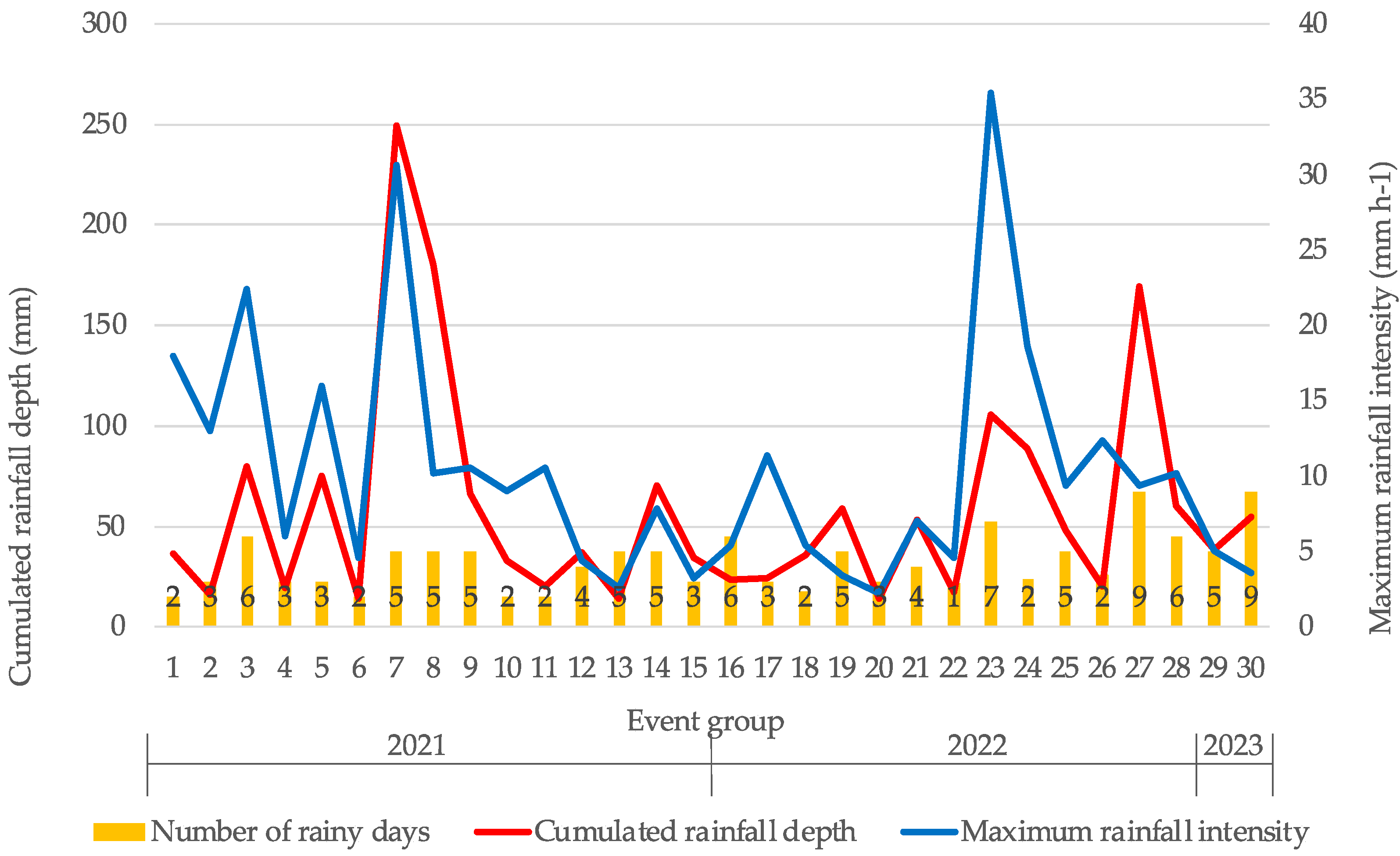




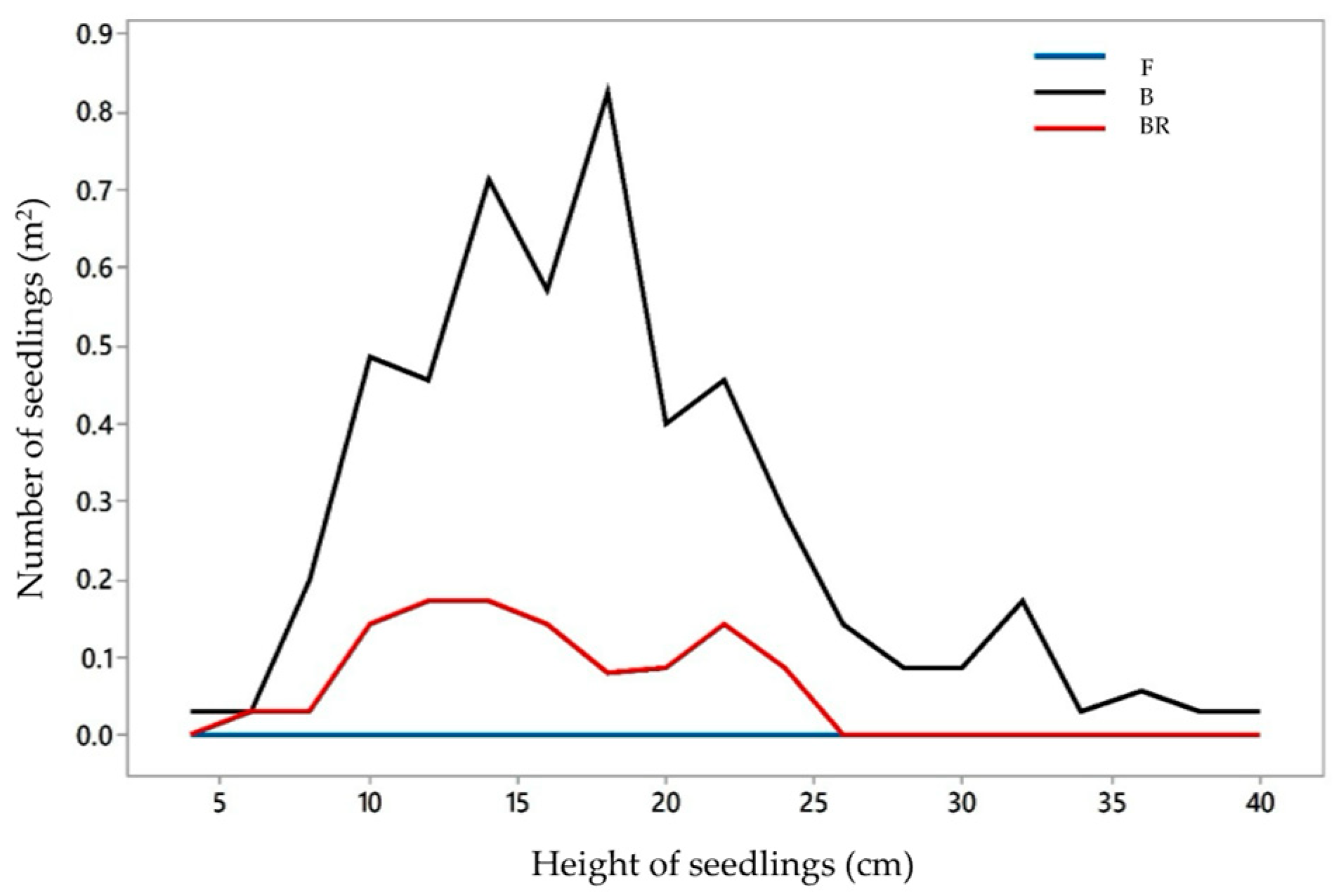
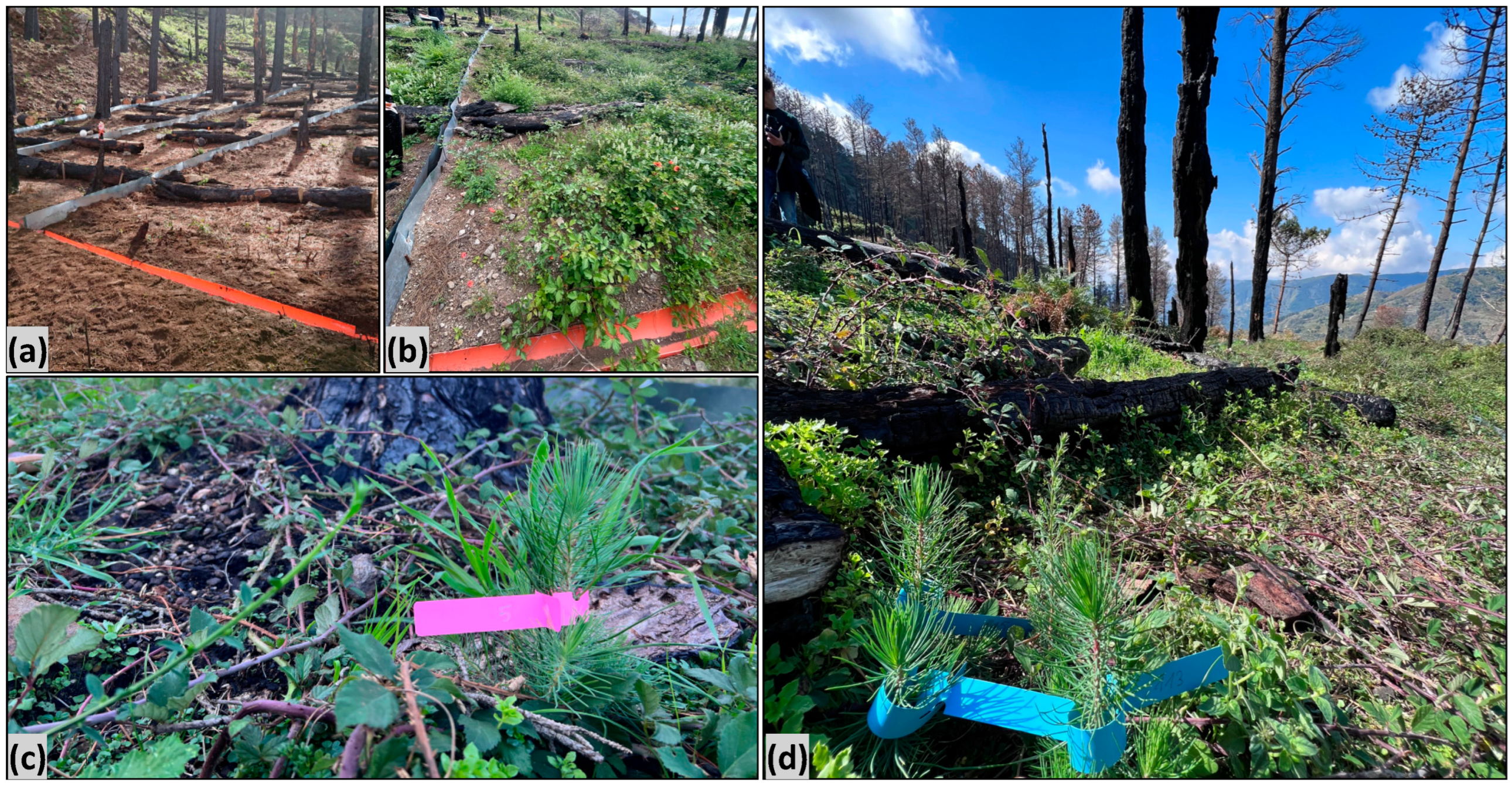




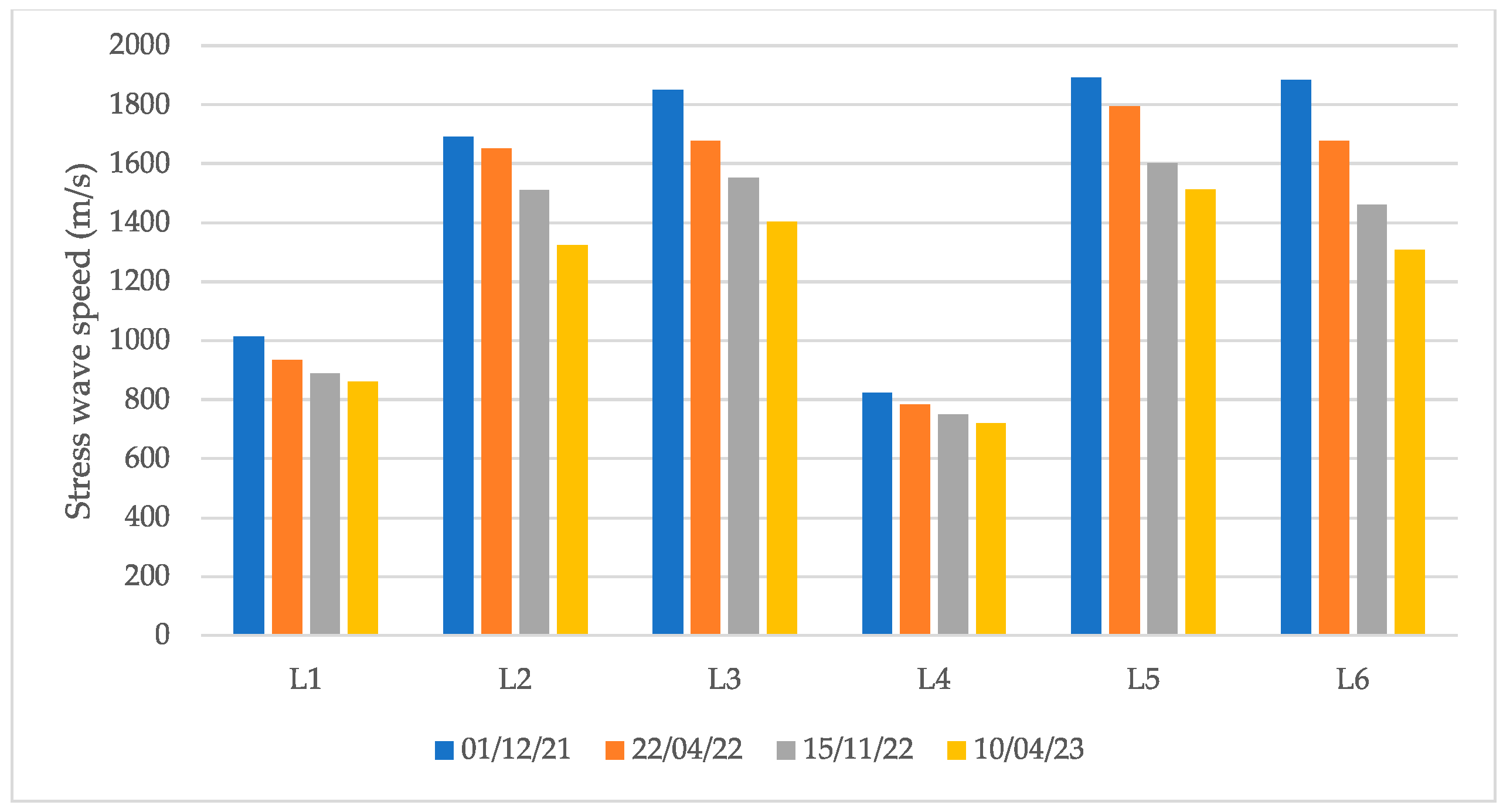
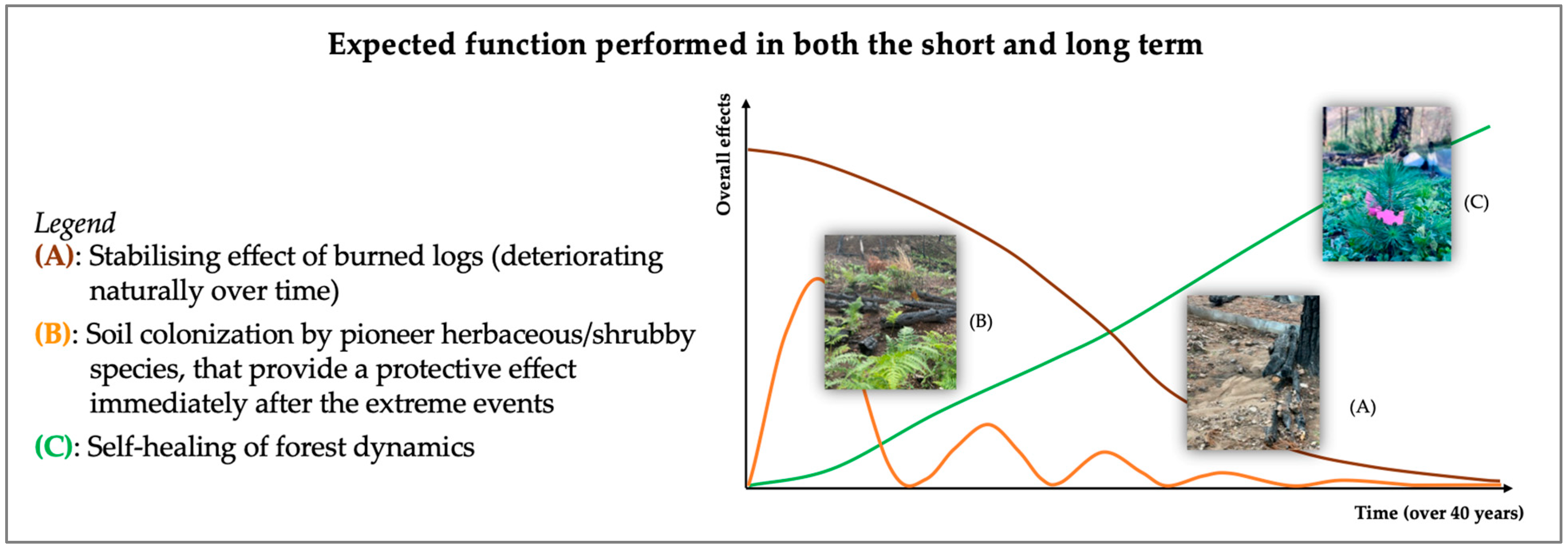
| From the previous work of Bombino et al. [58]: | |
 | |
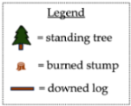 | F = forested B = burnt with randomly felled logs BR = burnt rearranged with manually redirected downed logs along contour lines. Down slope: 20 ± 2% Sub-plot type and measure: Wischmeier and Smith, 22 × 5 m |
| Delimitation and hydraulic isolation of each sub-plot by aluminium foil inserted into the soil to a depth of 20 cm | |
| Sub-plots B | Length of downed logs: 1.5 to 4 m |
| Sub-plots BR | Length of downed logs: ≅4 m; average diameter = 33 cm (from 21 to 49 cm) Downed logs redirected following the contour lines of individual sub-plots and reallocated at an average downslope distance of 4 m, resulting in partial fragmentation of the slope path; fixed with wooden stakes. The ratio between the sub-plot area (110 m2) and the total length of the contour logs was within the range of 3.9–4.6 m. |
| Only manual work (for in situ manual rotation of downed logs, two operators for few days ha−1) and light equipment (hammer) were required. |  |
Disclaimer/Publisher’s Note: The statements, opinions and data contained in all publications are solely those of the individual author(s) and contributor(s) and not of MDPI and/or the editor(s). MDPI and/or the editor(s) disclaim responsibility for any injury to people or property resulting from any ideas, methods, instructions or products referred to in the content. |
© 2024 by the authors. Licensee MDPI, Basel, Switzerland. This article is an open access article distributed under the terms and conditions of the Creative Commons Attribution (CC BY) license (https://creativecommons.org/licenses/by/4.0/).
Share and Cite
Bombino, G.; D’Agostino, D.; Marziliano, P.A.; Pérez Cutillas, P.; Praticò, S.; Proto, A.R.; Manti, L.M.; Lofaro, G.; Zimbone, S.M. A Nature-Based Approach Using Felled Burnt Logs to Enhance Forest Recovery Post-Fire and Reduce Erosion Phenomena in the Mediterranean Area. Land 2024, 13, 236. https://doi.org/10.3390/land13020236
Bombino G, D’Agostino D, Marziliano PA, Pérez Cutillas P, Praticò S, Proto AR, Manti LM, Lofaro G, Zimbone SM. A Nature-Based Approach Using Felled Burnt Logs to Enhance Forest Recovery Post-Fire and Reduce Erosion Phenomena in the Mediterranean Area. Land. 2024; 13(2):236. https://doi.org/10.3390/land13020236
Chicago/Turabian StyleBombino, Giuseppe, Daniela D’Agostino, Pasquale A. Marziliano, Pedro Pérez Cutillas, Salvatore Praticò, Andrea R. Proto, Leonardo M. Manti, Giuseppina Lofaro, and Santo M. Zimbone. 2024. "A Nature-Based Approach Using Felled Burnt Logs to Enhance Forest Recovery Post-Fire and Reduce Erosion Phenomena in the Mediterranean Area" Land 13, no. 2: 236. https://doi.org/10.3390/land13020236
APA StyleBombino, G., D’Agostino, D., Marziliano, P. A., Pérez Cutillas, P., Praticò, S., Proto, A. R., Manti, L. M., Lofaro, G., & Zimbone, S. M. (2024). A Nature-Based Approach Using Felled Burnt Logs to Enhance Forest Recovery Post-Fire and Reduce Erosion Phenomena in the Mediterranean Area. Land, 13(2), 236. https://doi.org/10.3390/land13020236












